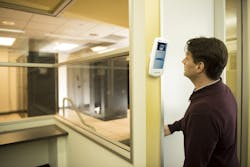SRI International debuts its 'SRI Identity' branded business line at ISC West
LAS VEGAS - SRI International is certainly no stranger to the access control market having been one of the leading providers of biometric solutions for a number of years. However, at this year’s ISC West show in Las Vegas, the company is rolling out a new branded business line called “SRI Identity” as part of an effort to really set the company’s identity verification offerings apart.
“What we’ve done is taken the biometrics within SRI and named it SRI Identity because it is about more than just biometrics, it really is about the authentication of identity,” said Mark Clifton, president, Products and Solutions Division, and vice president at SRI International. “We’ve been in the Iris recognition business for over 20 years and since iris is the most accurate biometric, we thought that was the right to place to focus. Our goal has been to make iris recognition easy to use and make it work at distance, on the move and in all lighting conditions.”
Bringing all of their biometric projects under the same business umbrella will provide SRI with the ability to better coordinate their activities within the different vertical markets in security, according to Clifton.
“It does give you a more focused approach to the different markets and allows you to really make sure you’re addressing the needs of the customers,” he said.
One of the company’s first products to be introduced as a part of this new business line is the IOM (Identity on the Move) Access Control Tablet, which aims to bring the convenience and functionality of its iris recognition technology to a wide range of commercial security applications. Developed in conjunction with Samsung, the tablet fuses an access control reader, biometrics, keypad, intercom, camera, and other capabilities together into a single, easy to use solution.
“It acts as a multi-function access control device. It has a biometric, but it also has all of the other features of a tablet, so you could put a PIN pad in there as well. It can also open doors with Wiegand or with IP-based transfers,” said Clifton.
Built on the scalable Android operating system, the tablet can provide additional functionality beyond its access control functions such as time and attendance, two-way video communications, employee alerts and scheduling without additional equipment. With its ability to replace multiple devices, the tablet delivers tangible cost savings for end users.
Looking at the overall product landscape in identity verification, Clifton believes too many companies have developed their solutions based solely around the authentication of something a person has – driver’s license, access credential, etc. – or on something they know, such as a PIN number. Clifton advocates using a solution that incorporates multi-factor authentication.
“Multi-modal capabilities are useful, so ‘who you are’ and ‘what you know’ are useful methods of authentication,” added Clifton.
And while biometric authentication used to be only solution reserved only for high-security applications, the technology has become much more mainstream in recent years and Clifton believes their new tablet solution will make it even more so.
“With our work with Samsung and the tablet, we’ve been able to really drive the cost out of the devices, so we’ve used our techniques to make it fast and easy to use but we’ve also brought the cost down significantly,” said Clifton. “Because it is multi-function, you get a lot more than just an access control device.”
While the proliferation of biometric sensors on smartphones has made people more accepting of biometrics than they once were, Clifton said the industry has also worked hard to improve the technology’s accuracy.
“Especially in the iris area, the false accept levels are extremely low. They approach almost DNA-level as far as their accuracy, so if you’re able to get recognition on two irises, your false accept rate is about one in 1.4 trillion encounters,” he said. “It comes down to whether or not you can capture a good iris and a lot of our systems have really worked hard to solve that problem as well.”



